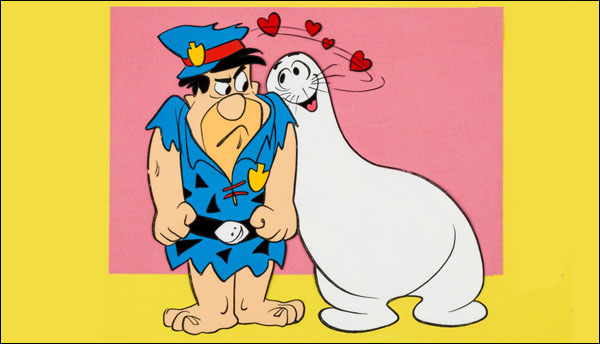
The “Modern Stone-Age Family,” a Marvel superhero and a character out of the newspaper comics all walk into Saturday morning. There’s no punchline here; this was an offbeat combination produced by Hanna-Barbera for Saturday morning television – Fred and Barney Meet The Shmoo.
In their book Saturday Morning Fever: Growing Up With Cartoon Culture, authors Timothy and Kevin Burke noted that the show came along at an interesting time in Saturday morning TV history. They wrote, “According to [then CEO and President of NBC, Fred] Silverman, at the end of the seventies and beginning of the eighties, the networks were pretty tired of Saturday morning. Hit shows were harder and harder to come by.”
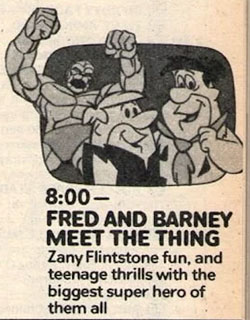 “NBC’s situation led to some hasty repackaging to grab ratings,” explains Greg Ehrbar, author of Hanna-Barbera: The Recorded History and host of The Funtastic World of Hanna and Barbera podcast. “Fred Silverman became notorious for high-concept series and convoluted program packaging as he hustled to keep NBC above water.
“NBC’s situation led to some hasty repackaging to grab ratings,” explains Greg Ehrbar, author of Hanna-Barbera: The Recorded History and host of The Funtastic World of Hanna and Barbera podcast. “Fred Silverman became notorious for high-concept series and convoluted program packaging as he hustled to keep NBC above water.
“The New Fred and Barney Show premiered in early 1979. It stayed on the schedule for the new fall season in September as Fred and Barney Meet the Thing, adding cartoons starring that character. Also in September, NBC introduced H-B’s The New Shmoo, originally a stand-alone series. By December, the network, scrambling to compete with ABC and CBS, put all three segments together as Fred and Barney Meet The Shmoo. The Thing cartoon was still in the mix, but not in the title.”
“Out of the over one hundred cartoons Hanna-Barbera Productions created, Fred and Barney Meet the Shmoo might be the weirdest, and not just because the title characters never actually meet,” said Noah Bell, writer, animation historian, and creator of the Hanna-Barbera blog, The Exposure Sheet, who added, “Beyond the odd pairing of characters, the show also took some equally odd liberties in their depictions.”
A number of Hanna-Barbera’s talented artists and legends of the industry worked on Fred and Barney Meet the Shmoo, including Iwao Takamoto, Hugh Fraser, Ed Barge, Gil DiCicco, Robert Alvarez, and Iraj Paran, just to name a few.
The Flintstones episodes on the show were from The New Fred & Barney Show, a Saturday morning re-boot of Hanna-Barbera’s hit prime-time animated series. On this iteration, Fred & Barney would get entangled in very’ 70s-fueled adventures, which included disguising themselves as a Kiss-like rock group and buying CB radios for their cars.
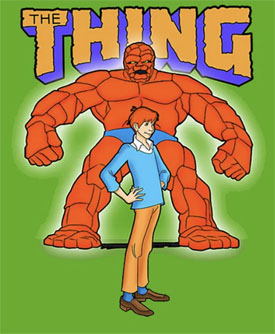 The Thing, of course, was the giant rock-like superhero member of Marvel comics The Fantastic Four, who had made his debut in 1961. His human alter-ego in the comics was astronaut Ben Grimm.
The Thing, of course, was the giant rock-like superhero member of Marvel comics The Fantastic Four, who had made his debut in 1961. His human alter-ego in the comics was astronaut Ben Grimm.
In his book Marvel: Five Fabulous Decades of the World’s Greatest Comics, author Les Daniels writes, “In the original synopsis that writer-editor Stan Lee gave artist Jack Kirby, Lee proposed making The Thing into ‘the heavy.’ Deformed, underprivileged, and argumentative, Ben actually became the most lovable group member: honest, direct, and free of pretension.”
In Hanna-Barbera’s incarnation, he was teenager Benjy Grimm, who could transform into the massive Thing when he would touch together the pieces of a magic ring and say, “Thing Ring, do your thing!”
The Shmoo was created by artist Al Capp in 1948 for his comic strip Li’l Abner. The strip centered on the title character and other characters in a fictional rural town called Dogpatch.
In Maurice Horn’s book, 100 Years of Newspaper Comics, contributor John A. Lent wrote that Li’l Abner brought with it “Some of the harshest commentary on American society and the human condition…”
One of the supporting players in the comic strip was a cute, little white, blob-like character with no arms, just feet and whiskers near its sweet face.
The Shmoo was very popular when it debuted. As Lent writes, “The Shmoos kept the people of the United States engrossed for a couple of months with their anti-capital, anti-labor and economy-of-plenty implications…”
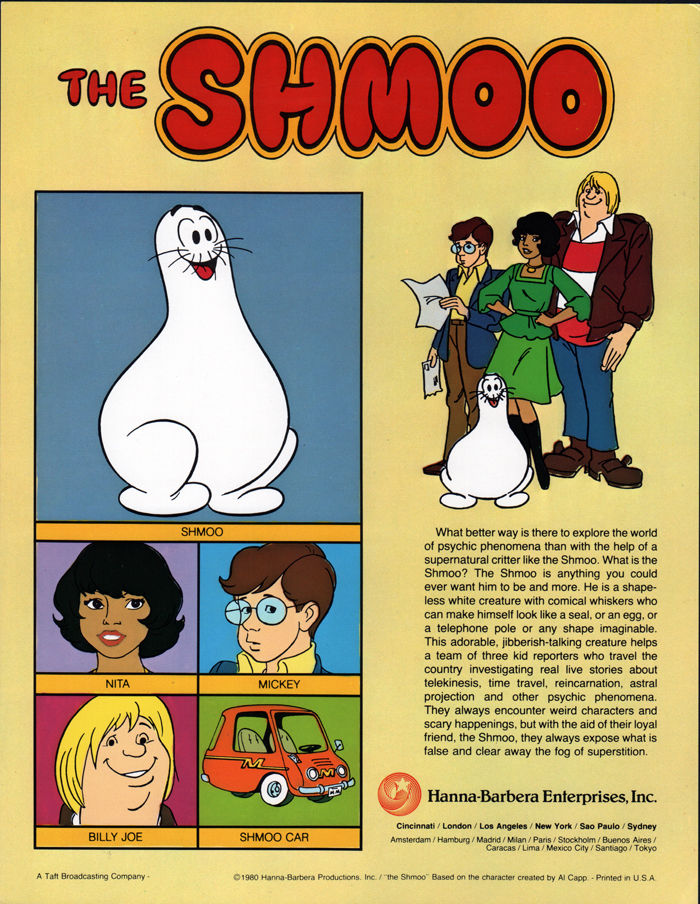
None of these “implications” characterized The Shmoo in Hanna-Barbera’s version. “The Li’l Abner comic strip depicted the Shmoo as a being that lived to please others, showing how humanity will take advantage of anything it can,” said Noah. “Hanna-Barbera reinvented the creature as a shapeshifting member of a Scooby-Doo-inspired mystery-solving gang, not unlike many of their other shows throughout the seventies.”
In Hanna-Barbera’s Shmoo, the creature teamed up with a group of young people, Mickey, Nita, and Billy Joe, who run Mighty Mysteries Comics. Shmoo here was like a pet (voiced with cute sounds by Frank Welker) who could morph and help everyone out of spooky situations.
“Despite its relative obscurity, Fred and Barney Meet The Shmoo was notable for several reasons,” said Noah. “The New Fred and Barney Show was the first series where Fred Flintstone was voiced by Henry Corden. Corden would go on to be the primary voice actor for the character until 2005.”
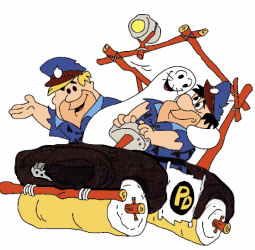 “Fred, Barney, The Thing, and the Shmoo characters never appeared together in this series (though Fred and Barney would be teamed with the Shmoo the following season – as policemen – in The Flintstone Comedy Show),” adds Greg. “However, in the Hanna-Barbera tradition harkening back to 1958 with The Huckleberry Hound Show, the characters did frolic during short interstitial segments between cartoon episodes and commercial breaks.
“Fred, Barney, The Thing, and the Shmoo characters never appeared together in this series (though Fred and Barney would be teamed with the Shmoo the following season – as policemen – in The Flintstone Comedy Show),” adds Greg. “However, in the Hanna-Barbera tradition harkening back to 1958 with The Huckleberry Hound Show, the characters did frolic during short interstitial segments between cartoon episodes and commercial breaks.
“There have been more than a few adults who recall Fred, Barney, and The Thing dressed as song-and-dance men, doing a peppy little soft-shoe routine, and aren’t sure if it really aired or they dreamed it. It was no dream—it was NBC in the era of Supertrain.”


 Michael Lyons is a freelance writer, specializing in film, television, and pop culture. He is the author of the book, Drawn to Greatness: Disney’s Animation Renaissance, which chronicles the amazing growth at the Disney animation studio in the 1990s. In addition to Animation Scoop and Cartoon Research, he has contributed to Remind Magazine, Cinefantastique, Animation World Network and Disney Magazine. He also writes a blog, Screen Saver: A Retro Review of TV Shows and Movies of Yesteryear and his interviews with a number of animation legends have been featured in several volumes of the books, Walt’s People. You can visit Michael’s web site Words From Lyons at:
Michael Lyons is a freelance writer, specializing in film, television, and pop culture. He is the author of the book, Drawn to Greatness: Disney’s Animation Renaissance, which chronicles the amazing growth at the Disney animation studio in the 1990s. In addition to Animation Scoop and Cartoon Research, he has contributed to Remind Magazine, Cinefantastique, Animation World Network and Disney Magazine. He also writes a blog, Screen Saver: A Retro Review of TV Shows and Movies of Yesteryear and his interviews with a number of animation legends have been featured in several volumes of the books, Walt’s People. You can visit Michael’s web site Words From Lyons at: 






















This is real bottom-of-the-barrel stuff right here.
Fred Silverman was the first television programming executive to become a household name, and there’s no gainsaying his impact on the medium. Without him, shows like “All in the Family”, “M*A*S*H*” and “Scooby-Doo, Where Are You?” would never have made it to air. But it must never be forgotten that Silverman was also responsible for some of the most misbegotten abominations in television history, such as “Supertrain”, “Thicke of the Night”, “Pink Lady and Jeff”, “The Harlem Globetrotters on Gilligan’s Island”, and worst of all, “The Brady Bunch Hour”. About the best you could say of him is that he didn’t actually come up with the idea for a talk show that teamed TV evangelist Tammy Faye Bakker with the gay guy from “Too Close for Comfort”, but it was the kind of boneheaded decision he was notorious for making. “Man with the golden gut,” my golden foot.
The Fred and Barney/Thing/Shmoo compendium ranks among Silverman’s worst failures. Certainly there was nothing wrong with the source material. The Flintstones’ status as the most successful primetime animated show of all time would remain unchallenged for over thirty years, and it still compares favourably with most live-action sitcoms of the 1960s. The Thing was the most compellingly complex, and at the same time the most popular, character in one of Marvel’s greatest franchises. The Shmoo story in “Li’l Abner” was the sharpest satire that ever appeared in a newspaper comic strip, and it was almost immediately reprinted in a stand-alone volume. When John Steinbeck won the Nobel Prize for Literature, he remarked that Al Capp deserved it more. (Having suffered through Steinbeck’s “The Pearl” in tenth grade English, I fully concur.)
But combining them into a single Saturday morning show is like putting strawberry ice cream, smoked salmon, and baba ghanouj together in a blender and expecting something palatable to result.
What other TV cartoon/comic book/ comic strip mélanges might Fred Silverman have concocted if he had the chance? Crusader Rabbit, the Silver Surfer, and Cathy? Felix the Cat, Howard the Duck, and Dondi? The Herculoids, the Fabulous Furry Freak Brothers, and Mary Worth? The mind reels.
From an associate of Fred Silverman on Mark Evanier’s website:
“Fred probably gets way too much credit for the shows that were hits and way too much blame for the ones that were flops.”
Fred Silverman also inherited Supertrain – he was not responsible for it.
Also, the characters are “combined” into a show in a similar way to many cartoon shows from Hanna Barbera (e.g. Secret Squirrel with Squiddly Diddly and Winsome Witch) , Warner Brothers (Road Runner Show with Tweety and Sylvester) and Total TV (King Leonardo, Tooter Turtle etc) –
And, as per this show and those examples, and quoted above in the article:
“the title characters never actually meet”
Using your food example, you wouldn’t put all those foods in a blender –
however in one meal you might eat Baba Ghanouj as an appetizer, Smoked Salmon for main course and Strawberry Ice Cream for dessert.
A similar experience to watching a variety of elements in one sitting with Fred and Barney Meet the Shmoo.
Ironically, I think there can be an audience for your off-the-wall combination of Felix the Cat, Howard the Duck, and Dondi. Maybe swap Dondi out for Cathy or Mary Worth, but at least pairing up Felix and Howard in the interstitials would provide some MST3K-style fodder.
The gay guy from “Too Close for Comfort” was Jim J. Bullock.
It’s sad when the heirs of an artist’s estate are so greedy for royalties they’ll allow the artist’s creation to be used in ways that would make the artist recoil with horror. We’re not supposed to care about Dr. Seuss anymore because once he drew a Chinese character with slant eyes and wearing a coolie hat, which of course makes him a monster, but he certainly wouldn’t approve of what’s been done to his work in the quarter century since he died (he didn’t even like what Chuck Jones did to the Grinch in 1965). Elzie Segar undoubtedly has been turning over in his grave for decades over Popeye’s gradual makeover.
With Al Capp it’s a little hard to know. There’s a pretty terrible 1940 Li’l Abner movie, the likewise 1944 Columbia cartoons (a couple of them aren’t bad, although sloppily produced), and a Broadway musical that retained some of the strip’s satire (watered down in the tacky film version). Capp died in November 1979 (I just looked it up), so it’s conceivable he gave Hanna-Barbera his own permission to use the Shmoo; maybe by then he just didn’t care.
Dondi wouldn’t last ten seconds with Howard.
Best comment for this article!
I am mainly interested in how they had The Thing/Ben Grimm in a Flintstones show…
The complete series of The Thing is currently on youtube.
The Bugs Bunny- Road Runner Hour which premiered during the 1968-69 season on CBS is one of the best examples of combing shows done right. When Fred Silverman arrived at NBC both primetime and Saturday morning schedules were in the ratings basement. Combing shows is gimmicky but only works if the shows being combined are already popular as stand alone series.
Another good example of combing shows properly would be Disney’s “Gummi Bears and Winnie the Pooh Hour” which aired on ABC ten years later after this show.
I have always been a diehard Flintstones fan. Since they were popular in my kindergarten and early elementary school years, I was delighted to find that they were still considered viable material for Saturday morning in my college years. Having Fred and Barney meeting anybody was cause for rejoicing in my book. After having more or less abandoned Saturday morning cartoons during my junior high and high school years, I found myself drawn back in during college by just such shows as these that brought back my old favorites. (Plus, the fact that I was taking a class that required me to critique the cartoons that were airing during that time on Saturday morning.)
Yes! I am a huge Flintstones fan myself! I wasn’t born until 1971, so I watched the reruns of the original Flintstones show in syndication and on Saturday morning I watched reincarnations of the Flintstones such as Pebbles & Bamm and The Flintstones comedy show. Anytime any of the characters from the Flintstones would show up on any cartoon (like Fred and Barney’s cameos in Scooby’s All-Star Laff A Lympics) I was l elated! I was happy they kept The Flintstones going basically up to the early 80s with the new Fred and Barney Show, Fred and Barney Meet the Thing/Shmoo and Fred & Barney Meet the Shmoo (I loved the Shmoo character and cartoon by the way!) I also loved The Flintstones cartoon specials aired during primetime such as A Flintstones Christmas and years later I Yabba Doo (Pebbles and Bamm Bamm getting married) and Rock A Bye-Baby (Pebbles and Bamm-Bamm having children). I wasn’t a huge fan of The Flintstones meet The Jetsons. I love The Jetsons too (only the original ones from the early 60s that again I saw in syndication in the late 70s not that silly new one in the late 80s) but I feel if they made The Flintstones meet The Jetsons in the 60s at the peak of both of the success of both cartoons, it would have been so much better, but that’s just my opinion. Yabba Doo to you my friend and a Water Buffalo cheer Ack-a-dack, dack-a-ack! LOL!
I’m kinda amazed no one mentioned the weirdest part of this whole show; was how for four weeks they aired a serialized Harlem Globetrotters special named The Harlem Globetrotters Meet Snow White.
WHAT WAS SILVERMAN ON?!?!?!!?